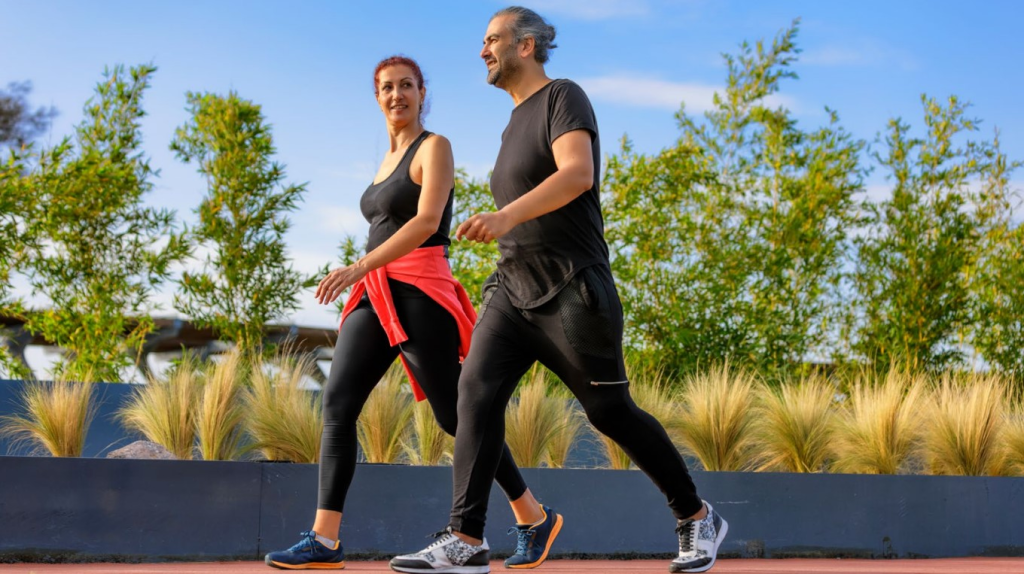When it comes to improving your health, both walking and running are excellent choices. These timeless activities are among the simplest and most accessible forms of exercise, offering a range of physical and mental benefits. But how do you choose between the two? The answer depends on your health goals, fitness level, and personal preferences. Let’s explore the unique advantages of walking and running, compare their impact on various aspects of health, and help you decide which might be better for you.

The Health Benefits of Walking
Walking is a low-impact activity that’s accessible to almost everyone, regardless of age or fitness level. Don’t let its simplicity fool you—walking offers a wealth of health benefits.
- Improves Cardiovascular Health
Walking increases your heart rate and improves blood circulation, which can lower blood pressure and reduce the risk of heart disease. Regular walks strengthen your heart and keep your cardiovascular system in good shape. - Supports Weight Management
While walking burns fewer calories than running, it’s still an effective way to maintain a healthy weight. A brisk 30-minute walk can burn up to 150 calories, depending on your speed and weight. - Boosts Mental Well-Being
Walking promotes the release of endorphins, your body’s natural mood elevators. It can also reduce stress and anxiety, particularly when done in a peaceful outdoor setting. - Gentle on the Joints
As a low-impact exercise, walking is easy on the knees, hips, and ankles. It’s a safe choice for individuals with joint issues or arthritis.
The Health Benefits of Running
Running, on the other hand, is a high-intensity exercise that takes your fitness to the next level. It’s an excellent option for those seeking a more rigorous workout.
- Superior Cardiovascular Benefits
Running significantly increases your heart rate and lung capacity. Over time, this improves the efficiency of your cardiovascular system, reducing your risk of heart disease and stroke. - Effective for Weight Loss
Running burns nearly double the calories of walking in the same amount of time. If shedding pounds is your goal, running is the faster route to success. - Strengthens Muscles and Bones
The repetitive impact of running helps build stronger bones and muscles, particularly in your legs. It also improves overall endurance and stamina. - Delivers a Mental Boost
Many runners report experiencing a “runner’s high,” a state of euphoria triggered by the release of endorphins. This intense mood boost can help reduce symptoms of depression and anxiety.
Walking vs. Running: A Side-by-Side Comparison
While both walking and running offer significant health benefits, they differ in intensity, calorie burn, and impact on the body. Let’s compare the two across key health factors.
- Cardiovascular Health
Both activities improve heart health, but running provides a more intense cardiovascular workout. It’s ideal for those looking to build endurance and improve heart and lung efficiency. - Weight Management
Running burns more calories per minute than walking, making it better for rapid weight loss. However, walking can still contribute to weight management, especially when combined with a healthy diet. - Joint Health
Walking is gentler on the joints and suitable for people with joint pain or arthritis. Running, due to its high-impact nature, can strain the knees and ankles, increasing the risk of injuries over time. - Mental Health Benefits
Both activities enhance mood and reduce stress. Running may offer a more intense emotional boost, while walking provides a calming, meditative experience.

Which Is Better for Joint Health?
If joint health is a concern, walking takes the lead. Its low-impact nature minimizes stress on your knees, hips, and ankles, reducing the risk of injuries like shin splints or stress fractures. For those with joint pain, arthritis, or a history of injuries, walking is a safer choice.
Running, while beneficial for building bone density, can exacerbate joint issues if done improperly or without the right footwear. To minimize risks, runners should invest in high-quality running shoes and practice proper form.
Mental Health: The Benefits of Moving Outdoors
Both walking and running can work wonders for your mental health, but the experiences they offer are slightly different. Running often provides a more intense release of endorphins, leading to the famed “runner’s high.” This can help alleviate symptoms of depression and anxiety.
Walking, on the other hand, is a more relaxed activity that encourages mindfulness and reflection. A leisurely stroll in nature can calm the mind, improve focus, and boost creativity. Whether you need an emotional pick-me-up or a chance to unwind, both activities deliver.
Which Is More Suitable for Beginners?
If you’re just starting your fitness journey, walking is the perfect entry point. It’s easy on the body, requires no special equipment, and allows you to build endurance gradually. Plus, it’s simple to incorporate into daily routines—think walking to the store or taking the stairs instead of the elevator.
For those interested in running, starting with a walk-run program is a great way to ease into it. Alternate between walking and short bursts of running, gradually increasing the running intervals as your fitness improves.

How to Choose the Right Activity for You
Deciding between walking and running ultimately depends on your goals, fitness level, and personal preferences. Here are a few factors to consider:
- Time Commitment: If you’re short on time, running provides a more efficient workout.
- Joint Health: For those with joint concerns, walking is the safer option.
- Calorie Burn: Running wins if rapid weight loss is your goal.
- Mental Health Needs: Choose walking for mindfulness and running for an endorphin rush.
Remember, you don’t have to choose one over the other. Many people enjoy combining both activities to keep their workouts varied and enjoyable.
Conclusion: The Best Exercise Is the One You’ll Stick With
Whether you prefer walking or running, the most important factor is consistency. Both activities offer incredible health benefits, from improved cardiovascular health to better mental well-being. Choose the one that aligns with your goals, fits your lifestyle, and, most importantly, brings you joy. After all, the best workout is the one you’ll look forward to doing again and again.


